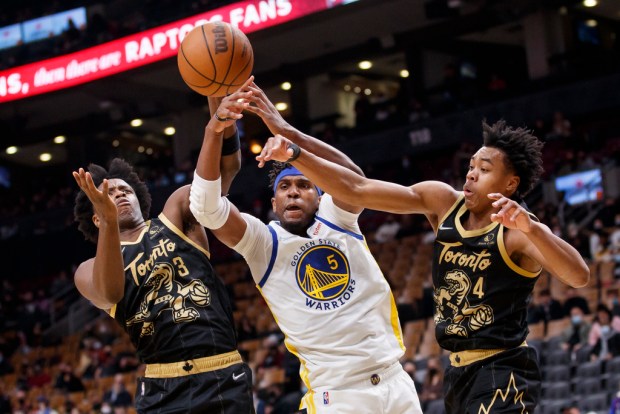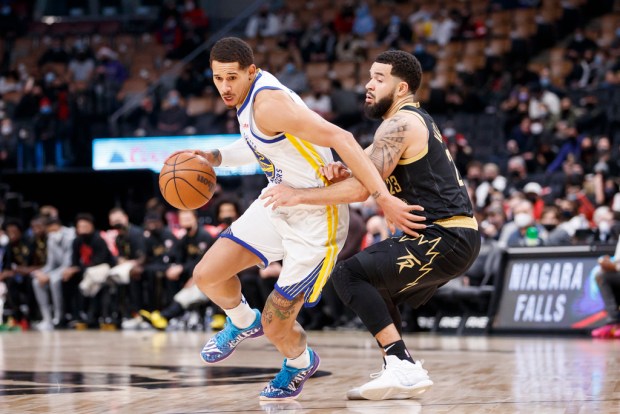TORONTO — As the Warriors loaded their gear into the team buses late Friday night in the labyrinth of tunnels beneath Boston’s TD Garden, coach Steve Kerr was still in the process of deciding who would play the following night and whether the entire team would trek across the Canadian border for the finale of their road trip against the Toronto Raptors.
Bags were loaded on to the bus and unloaded. Five players, including Steph Curry and Draymond Green were sent home, rather than risk getting stuck on the wrong side of the U.S.-Canada border for a game in which they weren’t going to suit up. A sixth player, Jordan Poole, had fallen victim to the league’s health and safety protocols and was stranded in his hotel room in Boston needing to test negative twice, 24 hours apart, in order to rejoin the team.
In a redux of the past two years, the complications caused by the COVID-19 outweighed the game on the court, a 119-100 loss in which the Warriors trailed from the get go and never pulled particularly close, played in front of a half-capacity crowd inside Scotiabank Arena under new rules put in place by the province of Ontario, the first regular-season NBA game this season played under such restrictions.
“The last few days have been really difficult, with Jordan Poole going into the protocol,” Kerr said before tipoff. “Everything was sort of up in the air, especially with the testing. We weren’t sure how many people were going to pass their tests.”
It all made for a stark reminder that the latest wave of the COVID-19 pandemic was upon us like the crashing surf off the California coast. (Or, more apt, maybe, in Toronto: a flurry of cases similar to the snow that was piling up Saturday outside Scotiabank Arena.)
“It feels like the whole league now is in a precarious spot,” Kerr said. “When you factor in the differences in the rules here and how that might manifest itself long term, all that stuff … We made the decision to do what we did thinking this is going to protect our team going forward.”
Even for fans listening at home, it was hard not to notice the absence of color analyst Jim Barnett, who was also stuck in a Boston hotel room after testing positive for COVID-19. His symptoms, so far, have been mild, limited to a scratchy throat. But Warriors play-by-play man Tim Roye was left doing the broadcast by himself for a second straight night.
On the court, Kevon Looney was the only member of the Warriors to assume his normal spot in the starting five. He scored 10 first-half points — the sixth time in his career he’s reached double figures in a half — and finished with 12.
Chris Chiozza and Damion Lee took the places in the backcourt normally occupied by Curry and Poole, while Juan Toscano-Anderson and Jonathan Kuminga filled out the Green and Andrew Wiggins’ spots. With nine players, the Warriors were only one above the NBA minimum, but six of them scored in double figures.
Kuminga, the 19-year-old lottery pick with freakish athleticism, was one of the few bright spots for Golden State its first double-digit loss of the season, a none too surprising result with the limited lineup the Warriors rolled out. Kuminga, though, was a frequent flyer to the hoop and even showcased a 3-point shot that until now had been missing from his repertoire.
With 26 points, he became the first Warriors rookie to score at least 25 points in his first NBA start since Chris Wright did it in 2012, according to the Elias Sports Bureau. His four 3-pointers on six attempts doubled his total from the entire season prior to Saturday.

The limited number of people inside the arena were forced to take additional precautions. Not only was everyone required to provide proof of vaccination, workers inside the arena had to return a negative result on a rapid test and take another PCR test after that. To enter the country, every member of the Warriors traveling party had to present negative test results within 72 hours of arrival. It was an even more complex process to get back into the U.S., with results required within 24 hours of traveling.
After Poole was caught up in COVID protocols following Thursday’s round of testing, everyone who made it into Canada was cleared for re-entry into the U.S. after undergoing testing Saturday morning at the team hotel. By tipoff, all those results had come back negative.
But, as evidenced by Poole’s unfortunate situation, that was no guarantee. Any player who tested positive could have also been forced to remain on the Canadian side of the border for 14 days in addition to entering the NBA’s health and safety protocols, which force any player who tests positive or comes in close contact who has to produce two negative PCR tests, 24 hours apart.

Those hoops proved too perilous to jump through for the Warriors group of veterans, who traveled directly back to the Bay Area from Boston, rather than cross the border and risk getting stranded 3,000 miles from home, like Poole. Curry, Green, Wiggins, Otto Porter Jr. and Andre Iguodala all flew back after Friday’s game in Boston.
“We know we’re not invincible,” Curry said Friday before departing Boston. “The odds are likely that you’ll be affected at some point.”
Despite the recent surge in cases and the tighter protocols they have prompted around the league, Wiggins said Friday that he hadn’t changed his thinking toward the vaccine. He was initially hesitant but received the shot in order to play at home under a local mandate.
“It is what it is, I guess,” Wiggins said.
With stricter new guidelines set to take effect for players who haven’t received their booster dose of the vaccine, Kerr said this week every Warriors player “who is eligible” had gotten their supplemental shot.
Iguodala, the business savvy veteran, wasn’t surprised the league was attempting to navigate the increased risk while still playing games.
“You dig through the data of the rules that are coming forth, it’s easy to see what the main objective is,” he said. “The main objective is always to what? We have a fiduciary responsibility to the shareholders.”
Poole, who entered health and safety protocols prior to Friday’s game, has yet to meet the requirements to rejoin his teammates. He and Barnett, the radio analyst, remained at the team hotel in Boston with an uncertain timeline to return. It’s unclear whether Poole tested positive or was exposed via a close contact to somebody who had.
When the Warriors embarked on their five-city road trip more than a week ago, concerns about the fast-spread Omicron variant were only in their infancy, but the latest surge exploded while they navigated the northeast portion of the continent, one of its primary hot spots.
The Warriors powered through two sets of back-to-back games — plus a broken-down private jet — to secure a winning record on the road trip before they even tipped off in Toronto.
“We are in the midst of a really rough schedule,” Kerr said. “It’ll be nice to get home. It’s been a long trip. It’s part of the NBA. Everybody goes through it. It just so happens this trip occurred during this surge and everybody’s antenna went back up.”
Source: www.mercurynews.com
